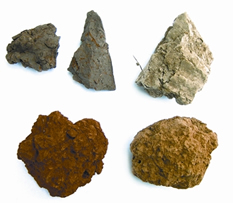Soil Colour
Soil Colour the most important and obvious property of soil, often used to describe or name it. The productivity of a soil can be predicted from its colour. A dark coloured soil is believed to be more productive than a light coloured one because a dark coloured soil contains more organic matter. Soils show a very wide variation in colour. A soil may be white, red, brown, grey, yellow or black. The colour of soils is related to their position in the landscape. The reduced soils usually have bluish and greenish tinges. Soils having higher organic matter become darker. Pure colours rarely occur in soils. Most often the colour of a soil is mixed. When patches of other colours occur on soil matrix colour it is called mottle. Mottles occur abundantly in soils having alternate wetting and drying conditions. The colour of mottles different from that of soil matrix.

The iron oxides have a outstanding contribution to soil colour. In soils different chemical processes occur under various conditions; permanently saturated, permanently non-saturated and alternately saturated and non-saturated. These differences particularly affect iron compounds, which almost all soil parent materials and soils contain.
This, in turn, affects soil colour. Grey soils occur under permanently saturated conditions where ferrous iron compounds are formed in the absence of oxygen or are washed out of the soil. Yellow, brown or red colours occur under non-saturated conditions where in the presence of air ferric iron compounds are formed. Colour of the same soil differs under different moisture conditions. It is, therefore, necessary to mention under what moisture condition the colour is recorded, ie, dry or wet.
Under alternately saturated and non-saturated conditions, which occur in many seasonally flooded soils in Bangladesh, patches of both grey and yellow-red colours are formed, giving rise to 'mottling'. Soil colour, therefore, is usually a good guide to soil drainage conditions. On the other hand, the repeated cultivation of many soils in Bangladesh-especially the puddling of soils for transplanted rice creates impervious topsoil which considerably modifies the physical and chemical properties of this layer, as well as its colour in many soils. [Md Sultan Hussain]
